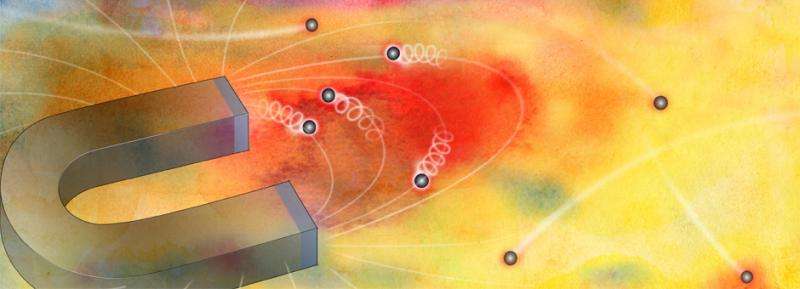Electrons 'puddle' under high magnetic fields, study reveals

Olympic figure skaters and electrons have a lot in common. In figure skating competitions, the "free skate" segment gives the skater the flexibility to travel in whichever pattern he or she chooses around the rink. Similarly, in metals, electrons in outer orbitals can wander fairly freely.
However, when the magnetic field is increased dramatically, researchers have found that the motion of these electrons becomes much more tightly confined. Their behavior looks like figure skaters completing compulsory tight spins and jumps.
In a new study from the U.S. Department of Energy's (DOE's) Argonne National Laboratory, researchers used extremely high magnetic fields—equivalent to those found in the center of neutron stars—to alter electronic behavior. By observing the change in the behavior of these electrons, scientists may be able to gain an enriched understanding of material behavior.
"The rules of the game are changed when we apply a magnetic field of this intensity," said Argonne materials scientist Anand Bhattacharya, who led the research. "The nature of this new state that we see has been debated theoretically for over half a century, but experiments to measure its properties have been hard to come by."
To create the very high magnetic field needed, Bhattacharya used the facilities of the National High Magnetic Field Lab in Tallahassee, Florida. There, with colleague Alexey Suslov, he examined crystals of strontium titanate, similar to synthetic diamond, which has the unusual property of allowing electricity to flow even when electrons are extremely sparse and slow-moving.
The slow motion of the electrons inside the crystal makes them particularly susceptible to magnetic forces. The researchers observed that the quantum properties of the electrons changed dramatically when the crystals were put under high magnetic fields and cooled down to just a few hundredths of a degree above absolute zero.
Former Argonne postdoctoral researcher Brian Skinner (now at MIT) and former National Institutes of Standards and Technology postdoctoral researcher Guru Khalsa (now at Cornell) provided the theoretical insights that helped the researchers understand their results. They proposed that in very high magnetic fields, the electrons form spatially inhomogeneous "puddles" a surprising finding that was supported by key aspects of the data.
Although Bhattacharya is hesitant to identify new technologies that could be created to take advantage of this new material regime, he said that the result is encouraging for scientists looking to develop a fuller understanding of the unusual properties of certain materials.
"When we push the limits to which we can take electrons, new physics emerges," Bhattacharya said. "If you think about our understanding of electrons, we understand metals, where electrons move freely, and we also understand the behavior of highly localized electrons. But if you can open the door to those in-between regions, you can make new discoveries."
More information: Anand Bhattacharya et al. Spatially inhomogeneous electron state deep in the extreme quantum limit of strontium titanate, Nature Communications (2016). DOI: 10.1038/ncomms12974
Journal information: Nature Communications
Provided by Argonne National Laboratory




















